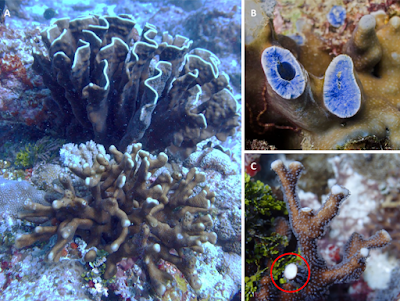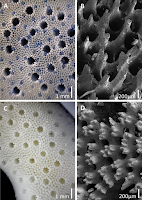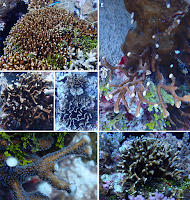[Most Recent Entries] [Calendar View]
Saturday, January 5th, 2019
| Time | Event | ||
| 1:54p | [Entomology • 2018] First Record of Epipompilus excelsus (Hymenoptera, Pompilidae) As A Koinobiont Ectoparasitoid of Ariadna mollis (Araneae, Segestriidae)
Abstract Epipompilus Kohl comprises 52 species of wasps that are parasitoids of spiders; 16 species occur in the Neotropical region and 36 species occur in the Australian region. The biological knowledge of this genus is limited and its interactions and host spiders are still incipient. Here, we report some behavioural and biological characteristics of E. excelsus, a parasitoid of the tube-dwelling spider Ariadna mollis. We observed an E. excelsus female attacking an adult female of A. mollis in São Paulo, Brazil. We photographed daily the larval development of the wasp, from the egg stage to adult emergence. The entire developmental cycle of the wasp took 24 days. This period was shorter than the developmental periods of wasps belonging to other genera of Pompilidae. Although all species within Pompilidae use spiders as host, they present great behavioural diversity, characterized by different ethological sequences. In conclusion, this study demonstrated that the Neotropical species of Epipompilus exhibit biological characteristics similar to the Australian species, acting as a koinobiont ectoparasitoid, but displays differences in larval morphology. Studies on other species could elucidate the extent of these differences and similarities, contributing to our understanding of the evolutionary history of Epipompilus, and consequently of Pompilidae. Keywords: Egg-wasp development, Neotropical, Parasitoid, Tube-dwelling spider German Antonio Villanueva-Bonilla, Antonio Domingos Brescovit, Eduardo dos Santos and João Vasconcellos-Neto. 2018. First Record of Epipompilus excelsus (Bradley, 1944) (Hymenoptera, Pompilidae) As A Koinobiont Ectoparasitoid of Ariadna mollis (Holmberg, 1876) (Araneae, Segestriidae). Journal of Hymenoptera Research. 66: 15-21. DOI: 10.3897/jhr.66.28915 | ||
| 2:03p | [Cnidaria • 2018] Heliopora hiberniana • Integrated Evidence Reveals A New Species in the Ancient Blue Coral Genus Heliopora (Octocorallia)
Abstract Maintaining the accretion potential and three dimensional structure of coral reefs is a priority but reef-building scleractinian corals are highly threatened and retreating. Hence future reefs are predicted to be dominated by non-constructional taxa. Since the Late Triassic however, other non-scleractinian anthozoans such as Heliopora have contributed to tropical and subtropical reef-building. Heliopora is an ancient and highly conserved reef building octocoral genus within the monospecific Family Helioporidae, represented by a single extant species – H. coerulea, Pallas, 1766. Here we show integrated morphological, genomic and reproductive evidence to substantiate the existence of a second species within the genus Heliopora. Importantly, some individuals of the new species herein described as Heliopora hiberniana sp. nov. feature a white skeleton indicating that the most diagnostic and conserved Heliopora character (the blue skeleton) can be displaced. The new species is currently known only from offshore areas in north Western Australia, which is a part of the world where coral bleaching events have severely impacted the scleractinian community over the last two decades. Field observations indicate individuals of both H. coerulea and H. hiberniana sp. nov. were intact after the 2016 Scott Reef thermal stress event, and we discuss the possibility that bleaching resistant non-scleractinian reef builders such as Heliopora could provide new ecological opportunities for the reconfiguration of future reefs by filling empty niches and functional roles left open by the regression of scleractinian corals. Systematics Subclass OCTOCORALLIA Haeckel, 1866 Order HELIOPORACEA Bock, 1938 Family Helioporidae Moseley, 1876 Genus Heliopora de Blainville, 1830 Diagnosis as for Family. Massive skeleton of crystalline aragonite, polyps in cylindrical tubes, interconnected via solenia. Type species Heliopora coerulea Pallas, 1766. Heliopora hiberniana sp. nov. Etymology: Latin, feminine, in reference to the type locality, adjectival form of Hibernia. Distribution: Hibernia Reef, Ashmore Reef, Scott Reef, Browse Is., NW Australia. Diagnosis: Heliopora hiberniana sp. nov. is distinguished from H. coerulea by a slender branching growth form, smaller and more numerous autopores, and highly elaborated echinulations. Some colonies (like the type material) are clearly distinguished by the presence of a white skeleton however this does not appear to be a fixed diagnostic trait as some H. hiberniana sp. nov. individuals retain the blue or intermediate colouration. H. hiberniana sp. nov. is distinguished from H. compressa Verrill, 1864 by its fine branching clump growth form and highly elaborated echinulations. Heliopora compressa is described to have a thick, massive or encrusting base that forms plates with thin edges or lobe-like branches. It also has 2–3 elaborations per echinulation rather than 3–6 as in H. hiberniana sp. nov. Heliopora hiberniana sp. nov. is distinguished by H. fijiensis Hoffmeister, 1945 by its fine branching clump form, smaller autopores (0.58–0.69 mm) and smaller number of pseudosepta (12–15). Heliopora fijiensis is known only from fossil material and it is described as having an encrusting growth form with 14–17 pseudosepta and an autopore diameter of 0.75–0.9 mm. The number of elaboration on echinulations were not recorded. Remarks: There are only three available names of Heliopora listed in the World Register of Marine Species: H. coerulea (Pallas, 1766), H. fijiensis Hoffmeister, 1945 † and H. compressa Verrill, 1864. All are differentiated from H. hiberniana sp. nov. by morphology. Heliopora fijiensis remains known only from fossil material, and H. compressa is considered a nomen dubium. The new species was observed growing in close association with Halimeda sp. at the type locality (Fig. 5). Squat lobster Alpheus obesomanus Dana, 1852 (Arthropoda; Crustacea; Malacostracea; Decapoda; Alpheidae) were observed residing in colony tips (Fig. 5F). Zoe T. Richards, Nina Yasuda, Taisei Kikuchi, Taryn Foster, Chika Mitsuyuki, Michael Stat, Yoshihisa Suyama and Nerida G. Wilson. 2018. Integrated Evidence Reveals A New Species in the Ancient Blue Coral Genus Heliopora (Octocorallia). Scientific Reports. 8, 15875. DOI: 10.1038/s41598-018-32969-z |
| << Previous Day |
2019/01/05 [Calendar] |
Next Day >> |









